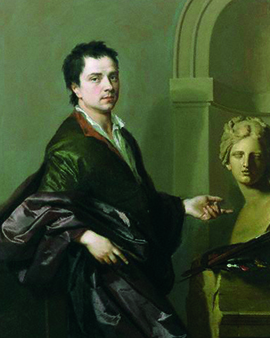Anyone who admires Michael Dahl's self-portrait, which is part of the collection of the National Portrait Gallery in London, would rather think of a French painter than a Swedish one. But this is not the only unconventional thing about this artist, around whom numerous mysteries entwine. One of the mysteries surrounding him is the day of his birth, whereby, strictly speaking, not even his year of birth is guaranteed. What is certain is that he did not see the light of day before 1656 and not after 1659. His origin is also in the dark. What is only known about his mother is that she probably belonged to the lower middle class and made numerous sacrifices in order to enable her son an education in London. His father was not worth mentioning to the historians.
Before Dahl set out to conquer London, he studied with the most famous Swedish painter of his time, David Klöcker Ehrenstrahl. The Swedish nobleman with German roots created the famous ceiling painting in the Knights' House in Stockholm. However, Ehrenstrahl only taught candidates who could convince his companion, the no less mysterious German-Hungarian painter and draughtsman Martin Hannibal, of their merits. Hannibal can today, curiously enough, no longer be attributed a single work, although he was known far beyond Sweden in the 17th century and was probably also very productive.
Thanks to the recommendation of his two teachers, the financial support of his mother and the help of a - you probably already guessed it - mysterious English merchant, Dahl finally arrived in London, where Godfrey Kneller, the leading portrait painter of the late 17th century, took him under his wing. With Kneller, the young Swede learned not only what makes a really good portrait, but also how to turn artistic talent into profit. Dahl not only earned his first spurs as a portrait and court painter in London, but also a small fortune. That, and probably his friendship with the promising young artist Henry Tilton, motivated him to go first to Paris and then to Rome.
Rome became a career springboard for Dahl. He owed his rise to another legendary figure in history. The talented young Mahler caught the attention of the Swedish ex-queen Christine, who had abdicated to convert to the Catholic faith. Christine established contact with Pope Innocent XI, who was impressed by Dahl's work and awarded him an order.
×





 engraved by Burnet Reading (fl 1776-1822) - (MeisterDrucke-69236).jpg)
 engraved by Burnet Reading (fl 1776-1822) - (MeisterDrucke-69236).jpg)
_wife_of_Francois_de_la_Rochefoucauld_-_(MeisterDrucke-317031).jpg)
_wife_of_Francois_de_la_Rochefoucauld_-_(MeisterDrucke-317031).jpg)
_holding_a_telescope_(long_view_-_(MeisterDrucke-1499422).jpg)
_holding_a_telescope_(long_view_-_(MeisterDrucke-1499422).jpg)
 - (MeisterDrucke-78249).jpg)
 - (MeisterDrucke-78249).jpg)
 first Lord of - (MeisterDrucke-233213).jpg)
 first Lord of - (MeisterDrucke-233213).jpg)
.jpg)
.jpg)
.jpg)
.jpg)
 c1711 - (MeisterDrucke-58547).jpg)
 c1711 - (MeisterDrucke-58547).jpg)
.jpg)
.jpg)
.jpg)
.jpg)
.jpg)
.jpg)
 1st Duke of Marlborough c1702 - (MeisterDrucke-179640).jpg)
 1st Duke of Marlborough c1702 - (MeisterDrucke-179640).jpg)
.jpg)
.jpg)
.jpg)
.jpg)
.jpg)
.jpg)
 1st Duke of Chandos - (MeisterDrucke-584083).jpg)
 1st Duke of Chandos - (MeisterDrucke-584083).jpg)
.jpg)
.jpg)
.jpg)
.jpg)
.jpg)
.jpg)
.jpg)
.jpg)
 - (MeisterDrucke-544103).jpg)
 - (MeisterDrucke-544103).jpg)
.jpg)
.jpg)
.jpg)
.jpg)
 - (MeisterDrucke-62776).jpg)
 - (MeisterDrucke-62776).jpg)
.jpg)
.jpg)
.jpg)
.jpg)
.jpg)
.jpg)
_c1691-1721_(oil_on_canvas)_-_(MeisterDrucke-1376565).jpg)
_c1691-1721_(oil_on_canvas)_-_(MeisterDrucke-1376565).jpg)
.jpg)
.jpg)
.jpg)
.jpg)
.jpg)
.jpg)
.jpg)
.jpg)
_Duchess_of_Devonshire_(oil_on_canvas)_-_(MeisterDrucke-1126843).jpg)
_Duchess_of_Devonshire_(oil_on_canvas)_-_(MeisterDrucke-1126843).jpg)
_late_17th_to_early_18th_century_(oil_-_(MeisterDrucke-1499172).jpg)
_late_17th_to_early_18th_century_(oil_-_(MeisterDrucke-1499172).jpg)
.jpg)
.jpg)
_c1679-17_-_(MeisterDrucke-1376635).jpg)
_c1679-17_-_(MeisterDrucke-1376635).jpg)
.jpg)
.jpg)
.jpg)
.jpg)
_aged_78_c_-_(MeisterDrucke-1376936).jpg)
_aged_78_c_-_(MeisterDrucke-1376936).jpg)
_and_his_Wife_Thomasine_Langston_Howard_-_(MeisterDrucke-1127302).jpg)
_and_his_Wife_Thomasine_Langston_Howard_-_(MeisterDrucke-1127302).jpg)
_-_(MeisterDrucke-1457879).jpg)
_-_(MeisterDrucke-1457879).jpg)
.jpg)
.jpg)
_-_(MeisterDrucke-1499175).jpg)
_-_(MeisterDrucke-1499175).jpg)
.jpg)
.jpg)
_-_(MeisterDrucke-1443481).jpg)
_-_(MeisterDrucke-1443481).jpg)
_-_(MeisterDrucke-1653092).jpg)
_-_(MeisterDrucke-1653092).jpg)
_c1705_(oil_on_canvas)_-_(MeisterDrucke-1510868).jpg)
_c1705_(oil_on_canvas)_-_(MeisterDrucke-1510868).jpg)
_-_(MeisterDrucke-1500975).jpg)
_-_(MeisterDrucke-1500975).jpg)
.jpg)
.jpg)
.jpg)
.jpg)
.jpg)
.jpg)




